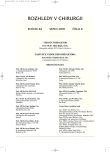-
Medical journals
- Career
Initial Experience with the Use of Fibrin Sealant for the Fixation of the Prosthetic Mesh in Laparoscopic Transabdominal Preperitoneal Hernia Repair
Authors: J. M. Langrehr; S. C. Schmidt; P. Neuhaus
Authors‘ workplace: Campus Virchow Clinic, Berlin, Germany ; University Medicine Berlin, Department for General-, Visceral- and Transplantation Surgery, Charite
Published in: Rozhl. Chir., 2005, roč. 84, č. 8, s. 399-402.
Category: Monothematic special - Original
Overview
Introduction:
Laparoscopic inguinal hernia repair offers more rapid recovery and less pain than with the traditional open approach. However, injury to the nerves of the lumbar plexus with subsequent chronic pain or neuralgia has a reported incidence of 2% during laparoscopic hernia repair, particularly when the transabdominal preperitoneal technique (TAPP) is used. These complications are inherent to the use of staples for fixation of the mesh. To avoid nerve irritation, we considered the use of fibrin sealant for the fixation of the mesh instead of staples. The aim of this study was to evaluate this technique and to compare the short-term follow-up of these patients with patients who underwent the staple repair technique. This is the first reported use of fibrin sealant in laparoscopic TAPP hernia repair.Method:
Between September and November 2004, we performed 17 consecutive laparoscopic hernia repairs (TAPP) in 14 patients (3 bilateral hernias) with primary hernias. The prosthetic mesh was fixed (10x15 cm) with 1 ml fibrin. The fibrin was applied using a special laparoscopic applicator. The peritoneum was closed with absorbable sutures. The postoperative course of these patients was compared with a cohort of matched patients who received the traditional staple fixation of the prosthetic mesh.Results:
Patients were evaluated at a median follow-up of 10.4 months (3.8–16.0 months). All patients underwent postoperative physical examinations. No recurrent hernia was found. There were 2 seromas and one hematoma in the stapled group. In the stapled group, one patient had pain in the area of the lateral femoral cutaneous nerve. There was no postoperative complication in the non-stapled group.Conclusion:
Fibrin fixation of the mesh during laparoscopic transabdominal preperitoneal inguinal hernia repair is feasible without higher risk of recurrences. In addition the fibrin fixation method may decrease postoperative neuralgia and reduce the incidence of postoperative seromas and hematomas.
Labels
Surgery Orthopaedics Trauma surgery
Article was published inPerspectives in Surgery

2005 Issue 8-
All articles in this issue
- Contemporary Trends in the Thoracic Surgery View to the History, Perspective
- Intracranial Meningiomas – Criteria for Selection of the Optimum Therapeutic Modality
- Surgery of Ventral Hernia Using Fascia Lata Graft
- Laparoscopic Surgical Procedures in Children with the Hirschprung’s Disease – Initial Experience
- Initial Experience with the Use of Fibrin Sealant for the Fixation of the Prosthetic Mesh in Laparoscopic Transabdominal Preperitoneal Hernia Repair
- Exenteration Procedures in the Pelvis
- Analysis of Surgical Procedures on the Vena Saphena Magna in the Czech Republic and an Effect of Detralex during its Stripping
- Effect of Laser Irradiation of Diode Laser on Healing of Surgical Wounds in Rats
- An Experimental Model of the Lymphatic Vessels Transplantation
- Modification of Surgical Treatment of Ingrowing Toenail
- New Concepts in Treatment of Gastric Carcinoma
- Perspectives in Surgery
- Journal archive
- Current issue
- Online only
- About the journal
Most read in this issue- Laparoscopic Surgical Procedures in Children with the Hirschprung’s Disease – Initial Experience
- Analysis of Surgical Procedures on the Vena Saphena Magna in the Czech Republic and an Effect of Detralex during its Stripping
- Modification of Surgical Treatment of Ingrowing Toenail
- Contemporary Trends in the Thoracic Surgery View to the History, Perspective
Login#ADS_BOTTOM_SCRIPTS#Forgotten passwordEnter the email address that you registered with. We will send you instructions on how to set a new password.
- Career

